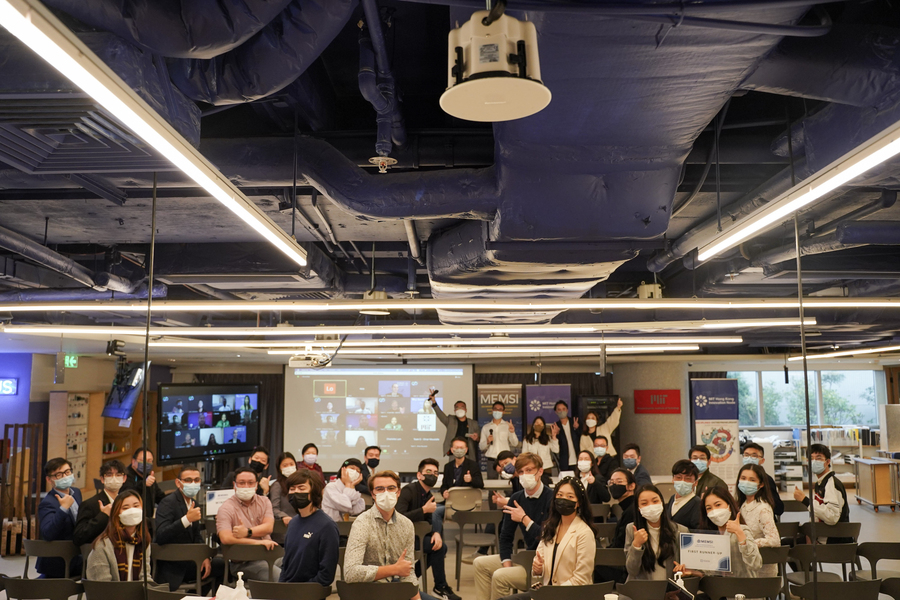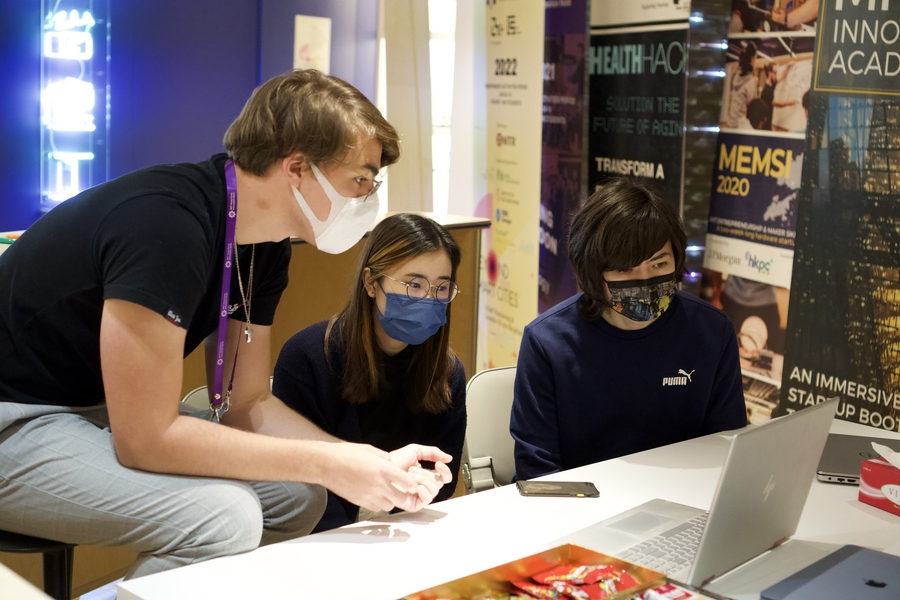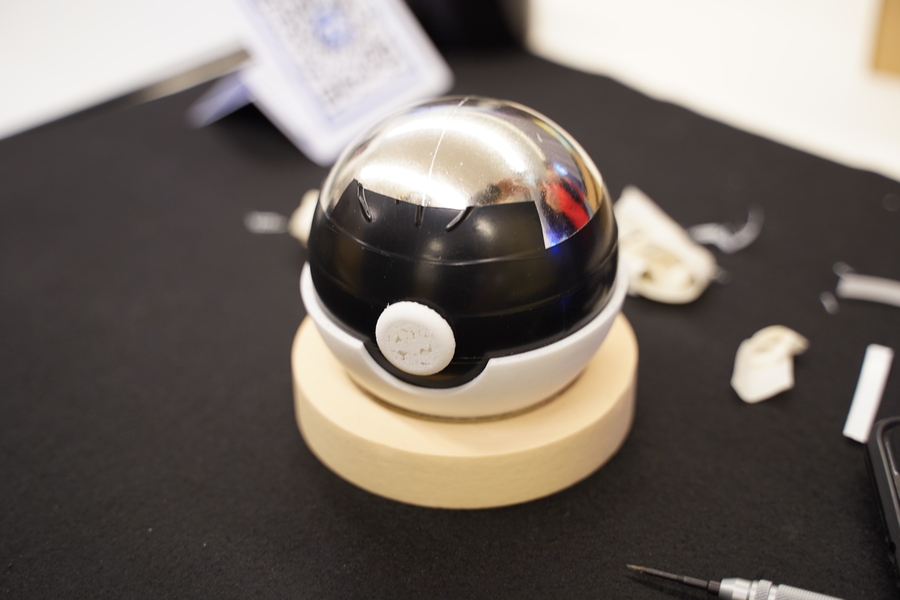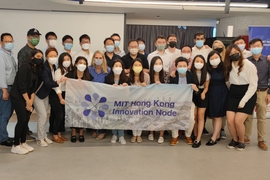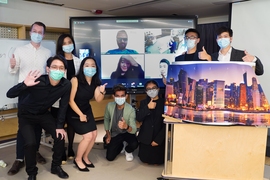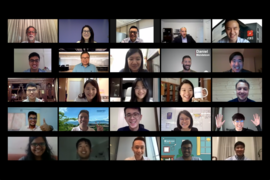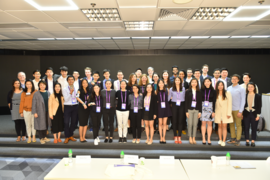MIT Hong Kong Innovation Node welcomed 33 students to its flagship program, MIT Entrepreneurship and Maker Skills Integrator (MEMSI). Designed to develop entrepreneurial prowess through exposure to industry-driven challenges, MIT students joined forces with Hong Kong peers in this two-week hybrid bootcamp, developing unique proposals for the Airport Authority of Hong Kong.
Many airports across the world continue to be affected by the broader impact of Covid-19 with reduced air travel, prompting airlines to cut capacity. The result is a need for new business opportunities to propel economic development. For Hong Kong, the expansion toward non-aeronautical activities to boost regional consumption is therefore crucial, and included as part of the blueprint to transform the city’s airport into an airport city — characterized by capacity expansion, commercial developments, air cargo leadership, an autonomous transport system, connectivity to neighboring cities in mainland China, and evolution into a smart airport guided by sustainable practices. To enhance the customer experience, a key focus is capturing business opportunities at the nexus of digital and physical interactions.
These challenges “bring ideas and talent together to tackle real-world problems in the areas of digital service creation for the airport and engaging regional customers to experience the new airport city,” says Charles Sodini, the LeBel Professor of Electrical Engineering at MIT and faculty director at the Node.
The new travel standard
Businesses are exploring new digital technologies, both to drive bookings and to facilitate safe travel. Developments such as Hong Kong airport’s Flight Token, a biometric technology using facial recognition to enable contactless check-ins and boarding at airports, unlock enormous potential that speeds up the departure journey of passengers. Seamless virtual experiences are not going to disappear.
“What we may see could be a strong rebounce especially for travelers after the travel ban lifts … an opportunity to make travel easier, flying as simple as riding the bus,” says Chris Au Young, general manager of smart airport and general manager of data analytics at the Airport Authority of Hong Kong.
The passenger experience of the future will be “enabled by mobile technology, internet of things, and digital platforms,” he explains, adding that in the aviation community, “international organizations have already stipulated that biometric technology will be the new standard for the future … the next question is how this can be connected across airports.”
This extends further beyond travel, where Au Young illustrates, “If you go to a concert at Asia World Expo, which is the airport’s new arena in the future, you might just simply show your face rather than queue up in a long line waiting to show your tickets.”
Accelerating the learning curve with industry support
Working closely with industry mentors involved in the airport city’s development, students dived deep into discussions on the future of adapted travel, interviewed and surveyed travelers, and plowed through a range of airport data to uncover business insights.
“With the large amount of data provided, my teammates and I worked hard to identify modeling opportunities that were both theoretically feasible and valuable in a business sense,” says Sean Mann, a junior at MIT studying computer science.
Mann and his team applied geolocation data to inform machine learning predictions on a passenger’s journey once they enter the airside area. Coupled with biometric technology, passengers can receive personalized recommendations with improved accuracy via the airport’s bespoke passenger app, powered by data collected through thousands of iBeacons dispersed across the vicinity. Armed with these insights, the aim is to enhance the user experience by driving meaningful footfall to retail shops, restaurants, and other airport amenities.
The support of industry partners inspired his team “with their deep understanding of the aviation industry,” he added. “In a short period of two weeks, we built a proof-of-concept and a rudimentary business plan — the latter of which was very new to me.”
Collaborating across time zones, Rumen Dangovski, a PhD candidate in electrical engineering and computer science at MIT, joined MEMSI from his home in Bulgaria. For him, learning “how to continually revisit ideas to discover important problems and meaningful solutions for a large and complex real-world system” was a key takeaway. The iterative process helped his team overcome the obstacle of narrowing down the scope of their proposal, with the help of industry mentors and advisors.
“Without the feedback from industry partners, we would not have been able to formulate a concrete solution that is actually helpful to the airport,” says Dangovski.
Beyond valuable mentorship, he adds, “there was incredible energy in our team, consisting of diverse talent, grit, discipline and organization. I was positively surprised how MEMSI can form quickly and give continual support to our team. The overall experience was very fun.“
A sustainable future
Mrigi Munjal, a PhD candidate studying materials science and engineering at MIT, had just taken a long-haul flight from Boston to Delhi prior to the program, and “was beginning to fully appreciate the scale of carbon emissions from aviation.” For her, “that one journey basically overshadowed all of my conscious pro-sustainability lifestyle changes,” she says.
Knowing that international flights constitute the largest part of an individual’s carbon footprint, Munjal and her team wanted “to make flying more sustainable with an idea that is economically viable for all of the stakeholders involved.”
They proposed a carbon offset API that integrates into an airline’s ticket payment system, empowering individuals to take action to offset their carbon footprint, track their personal carbon history, and pick and monitor green projects. The advocacy extends to a digital display of interactive art featured in physical installations across the airport city. The intent is to raise community awareness about one’s impact on the environment and making carbon offsetting accessible.
Shaping the travel narrative
Six teams of students created innovative solutions for the Hong Kong airport which they presented in hybrid format to a panel of judges on Showcase Day. The diverse ideas included an app-based airport retail recommendations supported by iBeacons; a platform that empowers customers to offset their carbon footprint; an app that connects fellow travelers for social and incentive-driven retail experiences; a travel membership exchange platform offering added flexibility to earn and redeem loyalty rewards; an interactive and gamified location-based retail experience using augmented reality; and a digital companion avatar to increase adoption of the airport’s Flight Token and improve airside passenger experience.
Among the judges was Julian Lee ’97, former president of the MIT Club of Hong Kong and current executive director of finance at the Airport Authority of Hong Kong, who commended the students for demonstrably having “worked very thoroughly and thinking through the specific challenges,” addressing the real pain points that the airport is experiencing.
“The ideas were very thoughtful and very unique to us. Some of you defined transit passengers as a sub-segment of the market that works. It only happens at the airport and you’ve been able to leverage this transit time in between,” remarked Lee.
Strong solutions include an implementation plan to see a path for execution and a viable future. Among the solutions proposed, Au Young was impressed by teams for “paying a lot of attention to the business model … a very important aspect in all the ideas generated.”
Addressing the students, Au Young says, “What we love is the way you reinvent the airport business and partnerships, presenting a new way of attracting people to engage more in new services and experiences — not just returning for a flight or just shopping with us, but innovating beyond the airport and using emerging technologies, using location data, using the retailer's capability and adding some social activities in your solutions.”
Despite today’s rapidly evolving travel industry, what remains unchanged is a focus on the customer. In the end, “it’s still about the passengers,” added Au Young.
